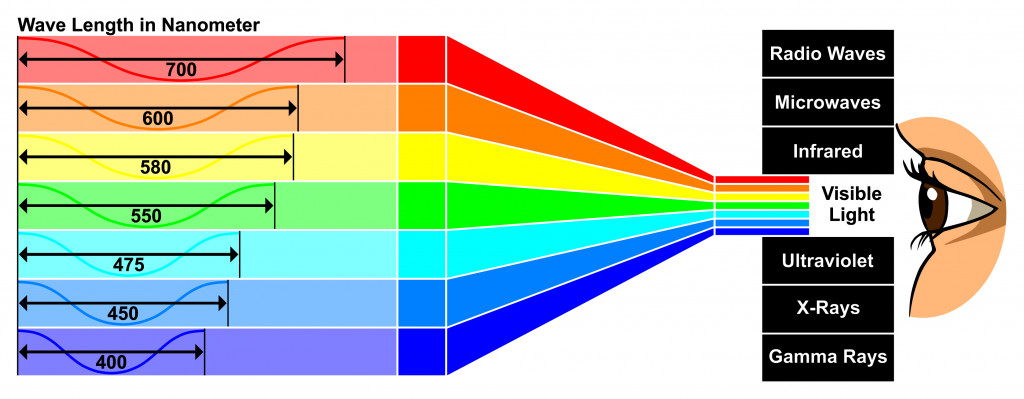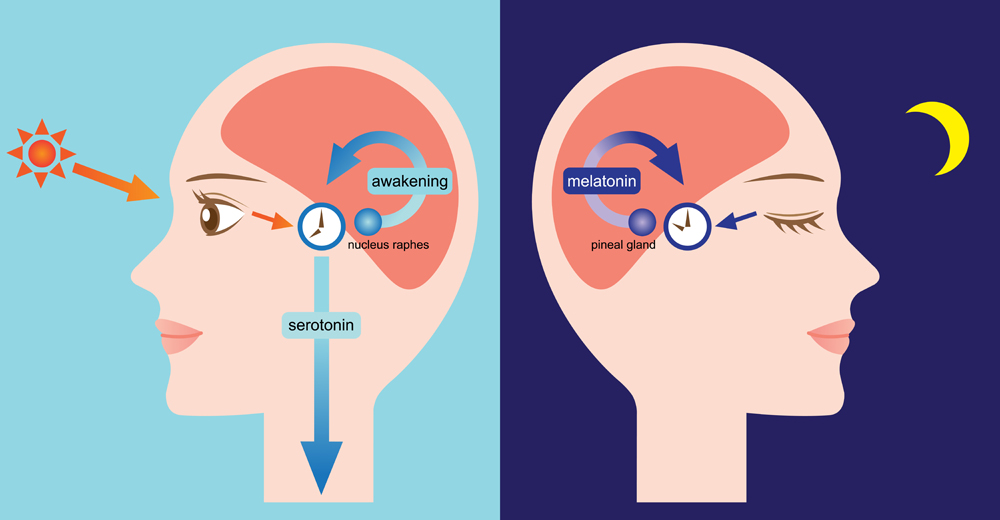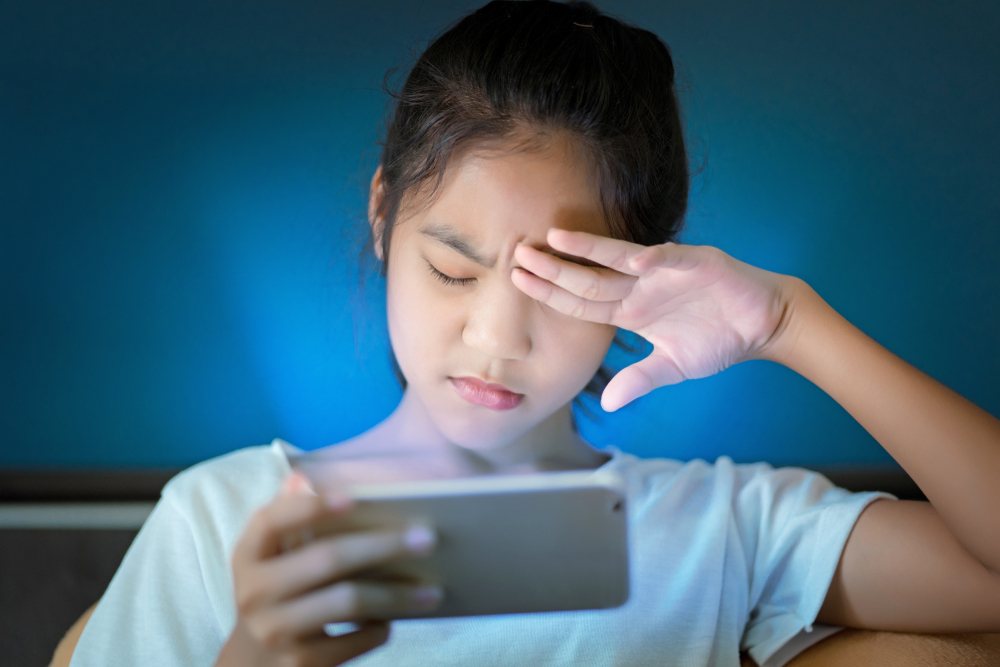Table of Contents (click to expand)
Blue light is the component of visible light with the shortest wavelength. It influences our Circadian rhythm and excessive exposure to blue light is harmful to our eyes.
For most of us, an action-packed and tiring day ends with a typical wind-down routine. We curl up in bed with the lights off, phones in our hands. The hours before sleep are often spent scrolling through an infinite cesspool of viral memes and cat videos. For others, obviously, reading articles on science blogs is the way to roll.
However, did you know that using your phone, tablet or laptop in the dark is not a very good idea? All screen-bearing electronic devices emit blue light, which has proven to be quite harmful for our eyes. It can actually physically damage our eyes, as well as disrupt our sleep cycles.
What Is Blue Light?
Blue light is everywhere, as it is emitted both by artificial light sources and by our biggest light source of them all – the sun!
Everything we see is the result of light rays bouncing off objects surfaces and being processed by our eyes. Human eyes are only able to process (“see”) light rays that fall within the visible light spectrum – light rays with wavelengths from 380 to 720 nanometers (nm). The fewer the nanometers, the shorter the wavelength.

This visible light spectrum can be divided according to wavelength into three categories: short (blue), medium (green), and red (long). Blue light begins at 380 nm and ends at 500 nm.
Light with shorter wavelengths have greater penetrative power. In 1900, Planck discovered the relationship between a photon’s (particle of light) frequency and its energy. Light with shorter wavelengths has higher frequencies, and the greater the frequency of light, the stronger is its energy.
The strong energy of blue light is what allows it to pass easily through the cornea and lens of our eyes. Blue light has the shortest wavelength in visible spectrum, and therefore also has the most energy and is the most harmful. Prolonged exposure to this slowly deteriorates the retina.
Limited exposure to blue light isn’t all that bad. After all, blue light is a part of sunlight. In fact, it is essential for regulating our sleep cycles. One way to get over jet lag is to spend time in direct sunlight. Why? Because the blue light from the sun resets our internal clocks. It is also why we are typically alert and active during the day, but feel drowsy and tired at night.
Also Read: What If We Could See All Wavelengths Of Light?
Blue Light And Its Effect On Our Health
Circadian rhythms are the internal biological clocks that all living organisms possess. It coordinates physiological and behavioral activities of living beings within 24 hr cycles. The Circadian rhythm is influenced by light intensity and the temperature of the living being’s environment.
There are two main hormones that regulate our Circadian rhythm: melatonin and serotonin. The former is also called the sleep hormone, while the latter is known as the “happy” or “feel good” brain chemical.
Melatonin secretion is triggered by the absence of light. Blue light from the sun regulates our Circadian rhythm by inhibiting melatonin secretion.
Serotonin secretion, on the other hand, is stimulated by sunlight. Serotonin improves cognitive function and is responsible for an alert and happy state of mind. As exposure to bright light increases (artificial or natural), there is a corresponding increase in serotonin.

Researchers have found that blue light also plays a role in regulating our mood and determining how we manage emotional challenges. Blue light is also shown to strengthen and stimulate connections between various parts of the brain that process language.
The recent problem, however, lies in the bright screen lights we stare at each night. This widespread use is why the harmful effects of blue light are coming into the limelight now, more than ever before. In other words, the problem isn’t exactly exposure to blue light, per se, but rather the extent and the timing of our exposure to it.

One study compared the difference between reading a physical book versus an e-book before bedtime. They observed that the participants who used an e-reader not only took longer to fall asleep, but were also less alert in the mornings. A likely reason for this is that exposure to the light-emitting reader’s blue light inhibits melatonin production, while increasing mental alertness. This leads to bad quality sleep and consequently lowered alertness the next morning.
So far, we have discussed the indirect effects of blue light on our body. The visual effects of blue light, however, are far more direct. As mentioned before, we humans have, over many millennia, adapted to the blue light in natural sunlight.
How have we evolved to deal with blue light? Our eyes’ natural lenses have certain protective structural proteins, along with specific enzymes, that absorb a high proportion of short wavelength light to protect our eyes.
Even so, over the years, as our eyes absorb harmful blue light, it leads to a condition widely known as cataracts. As these proteins and enzymes absorb short wavelength light, our lenses get cloudier and less transparent.
Not only that, but blue light’s penetrative power is also damaging to retinal cells. Exposure to blue light can even lead to the formation of reactive oxygen molecules (free radicals) in eye cells, which further contributes to cataract formation and macular degeneration.
Also Read: Why Should You Never Use Your Phone Before Going To Sleep
Blue Light Filters
So, what can we do to reduce the extent of damage caused by blue light? We can’t all turn into Luddites and stop using electronic devices, surely, which means that the answer is blue light filters.
As research has progressed and tech companies now understand the harmful effects of blue light, they started incorporating filters into devices that reduce the emission of blue light.
Laptops now come with the option of a night mode for their screen displays, making them much milder on the eyes. Certain Samsung phone models have in-built blue light filters. Using these modes or filters at nighttime is better for our eyes – and good for our sleep cycles too!
Apple, for example, offers a Night Shift app on their devices that uses the location and time of the device to automatically switch the color tone and filter out the blue light emission.
If your phone doesn’t have an in-built blue light filter, there are numerous blue light filtering apps available, both free and paid. These apps work by changing the color tone of your device screen.
Recent eyewear advertisements even speak of blue light-blocking spectacles, but whether or not they protect the eyes is still unproven.
Additionally, to protect the quality of your sleep, avoid electronic screens an hour or two before your bedtime. Switch back to reading a simple paper book before bed, even though that’s easier said than done. If you must use devices before bed, keep a night lamp on and activate the blue light filter on your electronic device.
We’re living in an age where it’s nearly impossible to avoid electronic devices and still function meaningfully in the world, but as is true of everything else in life, balance is key!
How well do you understand the article above!

References (click to expand)
- (2016) Effects of blue light on the circadian system and eye physiology. The National Center for Biotechnology Information
- Vicente-Tejedor, J., Marchena, M., Ramírez, L., García-Ayuso, D., Gómez-Vicente, V., Sánchez-Ramos, C., … Germain, F. (2018, March 15). Removal of the blue component of light significantly decreases retinal damage after high intensity exposure. (S. Barnes, Ed.), Plos One. Public Library of Science (PLoS).
- AUGUSTIN, A. J. (2008, October). The Physiology Of Scotopic Vision, Contrast Vision, Color Vision, And Circadian Rhythmicity. Retina. Ovid Technologies (Wolters Kluwer Health).
- Gomes, C. C., & Preto, S. (2015). Blue Light: A Blessing or a Curse?. Procedia Manufacturing. Elsevier BV.
- (2018, December 18). Research progress about the effect and prevention of blue light on eyes. International Journal of Ophthalmology. Press of International Journal of Ophthalmology (IJO Press).
- Blue light has a dark side - Harvard Health. Harvard University
- Chang, A.-M., Aeschbach, D., Duffy, J. F., & Czeisler, C. A. (2014, December 22). Evening use of light-emitting eReaders negatively affects sleep, circadian timing, and next-morning alertness. Proceedings of the National Academy of Sciences. Proceedings of the National Academy of Sciences.
- Schreiner, K. (2020, January). Dissecting the Response to Blue Light. Information Display. Wiley.
